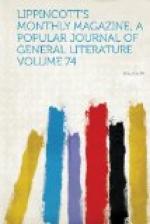As we drove along the hillside we began to notice frequent basin-like depressions of greater or less size, always perfectly circular, always with the same saucer-shaped dip, always without crack or fissure, yet appearing to have been formed by a gradual receding of the substructure, reminding one of the depression in the sand of an hour-glass or of the grain in a hopper. Many of these concaves were dry; others had a little water in the bottom; all of them had trees growing here and there, quite undisturbed, whether in the water or not; and there was no one who had cared to note how long a time had elapsed since they had begun their “decline and fall.” There is little doubt, however, that the future traveller will find them developed into lakes, as, indeed, we found one here and there upon the hilltops.
[Illustration: “THE ONLY GIRL IN THE PLACE.”]
How many times we got lost among the lakes and “pot-holes,” the fallen trees and thickets of Ekoniah Scrub, it would be tedious to relate. How many times we came down to the prairie-level, and, fearful to trust ourselves upon the treacherous, billowy green, were forced to “try back” for a new road along the hillside, it would be difficult to say. The county clerk’s itinerary had ended here, and William Townsend proved to be less ubiquitous than we had been led to expect. Thus it was that night came down upon us one evening before we had reached a place of shelter—suddenly, in the thick scrub, not lingeringly, as in the long forest glades of the lake country. For an hour we pushed on, trusting now to Barney’s sagacity, now to the pioneering abilities of Artist and Scribe, who marched in the van. Fireflies flitted about, their unusual brilliancy often cheating us into the fond hope that shelter was at hand. The ignes-fatui in the valley below often added to the deception, and after many disappointments we were about to spread our blankets upon the earth and prepare for a night’s rest al fresco when we heard a distant cow-call. Clear and melodious as the far-off “Ranz des Vaches” it broke upon the stillness, gladdening all our hearts. How we answered it, how we hastened over logs and through thickets in the direction of answering voices and glancing lights—no ignes-fatui now—how we were met halfway by an entire family whom we had aroused, and with what astonishment we heard ourselves addressed by name,—can better be imagined than described. By the happiest of chances we had come upon the home of some people whom we had casually met upon the St. John’s River only a few weeks before, and our dearest and oldest friends could not have welcomed us more cordially or have been more gladly met by us.
In the early morning we heard again, between sleeping and waking, the musical cow-call. It echoed among the hills and over the lakes: there were the tinkling of bells, the pattering of hoofs, the eager, impatient sounds of a herd of cattle glad of morning freedom. It was like a dream of Switzerland. And, hastening out, we found the dream but vivified by the intense purity of the air surcharged with ozone, the exquisite clearness of the outlines of the hills, the sparkling brightness of the lakes in the valley, the freshness of glory and beauty which overspread all like a world new made.




